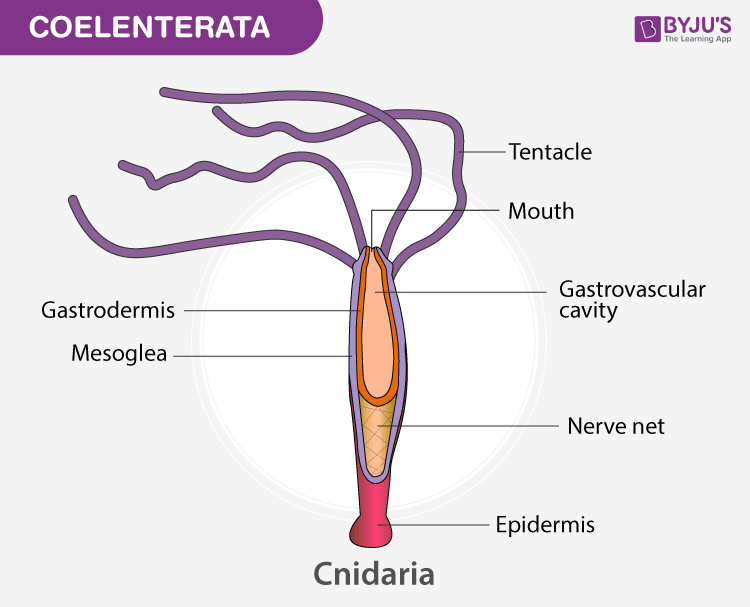Phylum Coelenterata is a group of aquatic, or marine organisms and a member of the Animal kingdom. They are usually found attached to the rocks at the bottom of the sea. These are the multicellular and simplest group of invertebrate animals, found in colonies or solitarily.

Characteristics of Coelenterata
- These are mostly aquatic or marine habitat animals.
- These species exhibit a tissue-level organization.
- The mouth is enclosed by thin and short tentacles.
- They are diploblastic animals, in which, the body is made up of two layers of cells:
- Ectoderm – One layer makes up the cells outside the body
- Endoderm – the other forms the inner lining of the body.
- They have cavities in their body.
- The body is radially symmetrical.
- The digestion is both intracellular and extracellular.
- The nervous system and the circulatory system is absent.
- They excrete and respire through simple diffusion.
- The mode of reproduction is asexual, which is through budding.
- The sexual mode of reproduction is seen only in a few Coelenterates.
E.g., Hydra, Rhizostoma, Xenia, etc.
Also Refer: Budding
Classification of Coelenterata
Coelenterates are classified into three different classes:
- Anthozoa
- Hydrozoa
- Scyphozoa
Hydrozoa
- These are mostly marine species, found exclusively in freshwater.
- Few are found in colonies and few are found solitarily.
- Asexual Polyps is the dominant form.
- Mesogloea is acellular.
E.g., Hydra, Obelia
Scyphozoa
- They are found exclusively in the marine environment.
- Medusa is dominant and umbrella-shaped.
- Polyps are not present.
- Mesogloea is cellular.
E.g., Aurelia aurita, Rhizostoma.
Anthozoa
- They are found exclusively in the marine environment.
- Mesogloea contains fibrous connective tissues and amoeboid cells.
- Medusa is not present.
E.g., Metridium, Xenia.
Learn more in detail about Phylum Coelenterata, its structure, functions and other related topics at BYJU’S Biology.
Also check: Physalia: Classification, Characteristics and Life Cycle
Recommended Video:

Related Links:-
| Protista |
| Pteridophyta |
Frequently Asked Questions
What are the characteristics of Coelenterates?
The Coelenterates are aquatic, mostly marine organisms. The body is radially symmetrical and exhibit a tissue-level organization. Their mouth is surrounded by sensory tentacles, which helps to capture their prey.
Why are Coelenterates called Cnidarians?
Coelenterates are called Cnidarians because they contain specialized cells called cnidoblasts. They possess stinging structures called nematocysts.
Why are coelenterates diploblastic?
Coelenterates are diploblastic because their boy is mainly composed of two cells layers namely, ectoderm and endoderm.
How do Coelenterates feed?
Coelenterates use tentacles to capture the food and draw it into the opening. Their poison is so deadly that it can paralyze very large creatures.
Are Cnidarians harmful to humans?
No, Cnidarians are not harmful to humans. This is because the stinging capsular organelles cannot penetrate into the human skin.

what are the examples of phylum coelonterata
Examples of coelenterates are Aurelia (jelly fish), Physalia (Portuguese man-of-war), Hydra, Adamsia (Sea anemone), Pennatula (Sea-pen), Obelia, Gorgonia (Sea-fan) and Meandrina (Brain coral), etc.
Are phylum coelenterata locomotive or non locomotive?
Polyps move slowly over rocks and sea by creeping, crawling or by somersaulting. Medusae swim by a form of jet propulsion.